Landing Falcon-9: a look from a specialist
Today's blog guest is rocket engineer Pavel Pushkin. At my request, he commented on the recent landing of the first stage of the Falcon-9 rocket, and gave an expert assessment of the condition of the returning rocket, according to published pictures.
Pavel Pushkin, formerly deputy head of the design and research center of FSUE GKNPTs im. M.V. Khrunicheva. " Now the general director of CosmoCurs LLC , a private Russian startup, which set the goal of creating a tourist rocket and capsule to compete for the space tourism market with Virgin Galactic and Blue Origin. Pavel Pushkin has been developing rockets for more than 10 years, participated in the creation of the Angara rocket, and now leads the development of his own suborbital rocket and spacecraft.

______________________________________
It should begin with the fact that there is nothing unexpected or surprising in the jet landing of the first stage of the Falcon-9. All this has long been calculated, including in our country. On the topic of “Ascent,” the idea of creating reusable missiles with a reactive landing of missile units was being worked out, and at the Salyut design bureau they proposed the revolutionary idea of not only a reactive landing at that time, but also the formation of a feedback loop with the return of the missile unit to the launch site. So such studies have been carried out for a long time both in our country and in the USA. At the same time and experienced a lot of flight equivalencies demonstrators have been developed in the US, where the most remarkable was the " Delta Clipper", Which practically made aerobatics in the air, followed by an exact jet landing. In principle, specialists who are actually engaged in reusability issues have long known the capabilities of a reactive landing scheme and the loss of payload mass to which this reusability scheme leads. The only thing that was not known was the cost of maintenance and repair work for carrying out repeated launches with a given reliability. At the same time, there were still problems in the USA with the fact that, starting from the east coast, the route ran over the waters of the ocean, which is theoretically difficult to get into. But as we see SpaceX took risks and began to try to land the first step on a barge, which is technically more difficult than landing on land. The most interesting, that when starting from Vostochny Cosmodrome, we will not have such problems with any launch azimuth - everywhere there is one land. If we talk about the successful landing of the first Falcon-9 stage, then SpaceX went for additional fuel costs to return the stage to the launch site.
So what does the Falcon-9 first-stage landing video tell us? Obviously, the landing was successful and fairly accurate. Further, everyone is interested in what state the stage landed on and whether it can be reused. Let's see the photo immediately after landing:
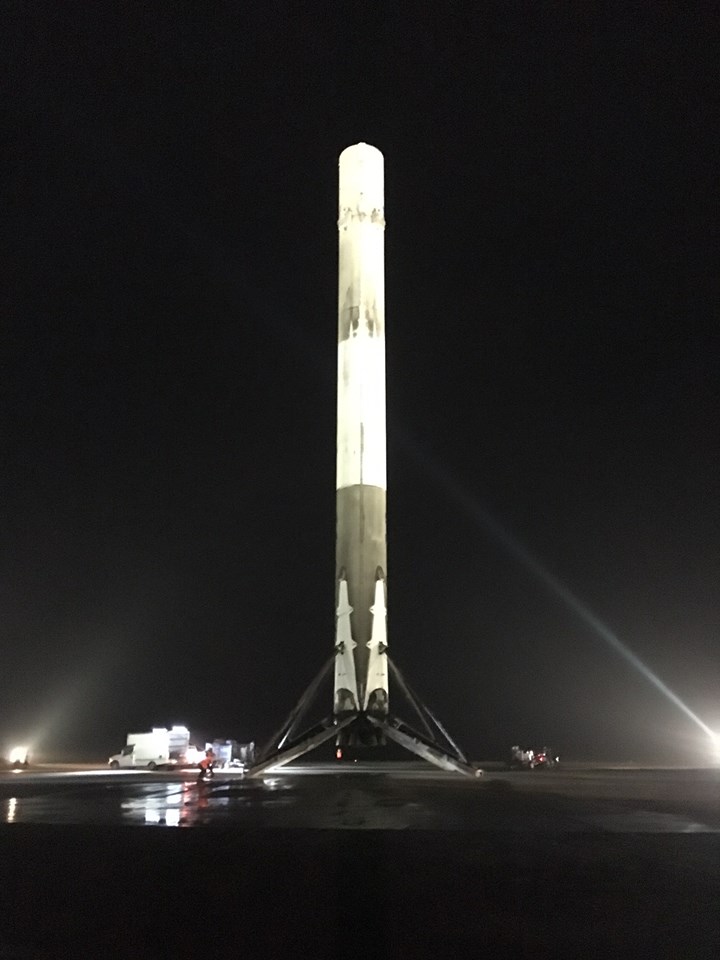
The photo shows that the step is level, the buckling or distortion of the shell of the tanks did not occur. At first glance, everything is very beautiful and intact, similar to servicing an airplane between landings. True step a little smoky. One interesting thing should be clarified here. This soot is not from the fact that the falling stage burned in the atmosphere, but from the fact that the engines were turned on to slow down when entering the atmosphere. This braking is done in order to reduce the heat fluxes coming to the stage (most likely to the walls of the tanks). Heat flows depend on the flight speed approximately in proportion to the speed in the cube. Therefore, braking by 30% gives a decrease in heat flows by about three times. According to calculations, approximately such braking was during the descent of the reusable Falcon-9 stage.
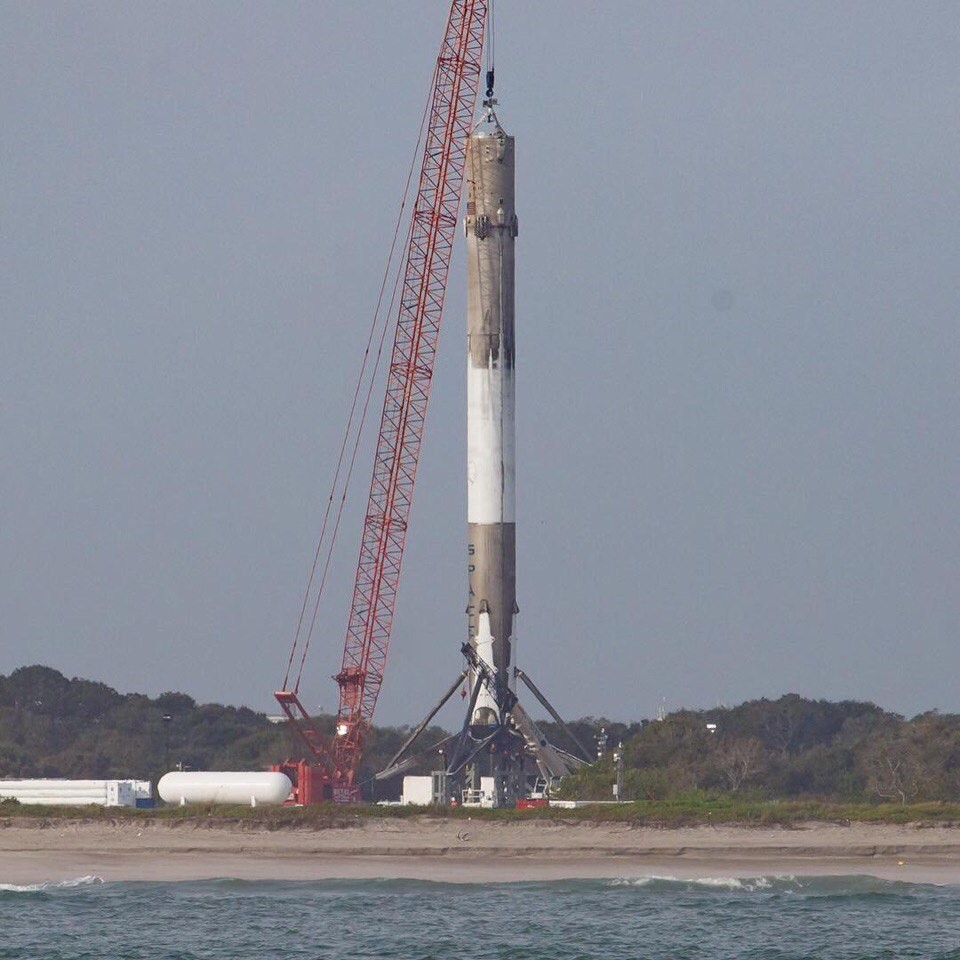
Then morning came and began to work with a step. The most important thing was to put it on the transport unit and take it to the hangar for further work. It was interesting what SpaceX would do with the landing poles. And they apparently raised the stage with a crane and simply disconnected the supports. True, this is not at all simple, since the upper communication center is high enough and for its release, high-altitude work using a crane is required. It is also required to disconnect all communications, put stubs. Then hang the support with a crane and lay it on the conveyor or at a temporary place of service. In order to prevent the step from hanging in the air, it was raised at the very beginning and rearranged to the technological structure. In theory, the removal of supports in real multiple launches may not occur and it is even advisable not to do this, you just need to fold them. But given that the landed test stage and most likely will not fly anywhere else, then removing the supports is a reasonable step.
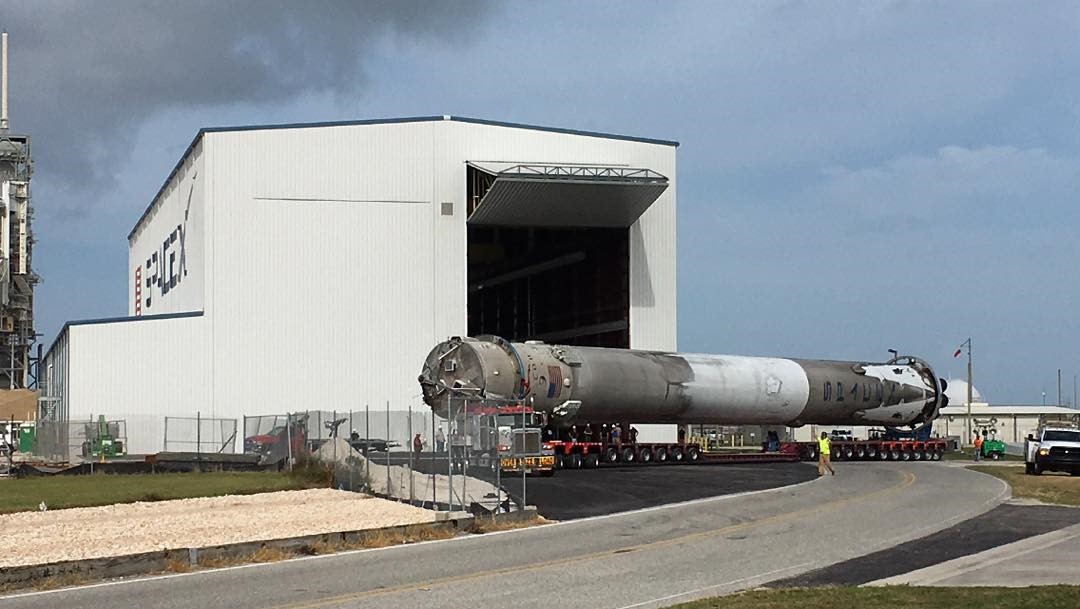
In this photo we see a step laid on a transport unit without landing supports. In this form, it was brought into the hangar for further work.
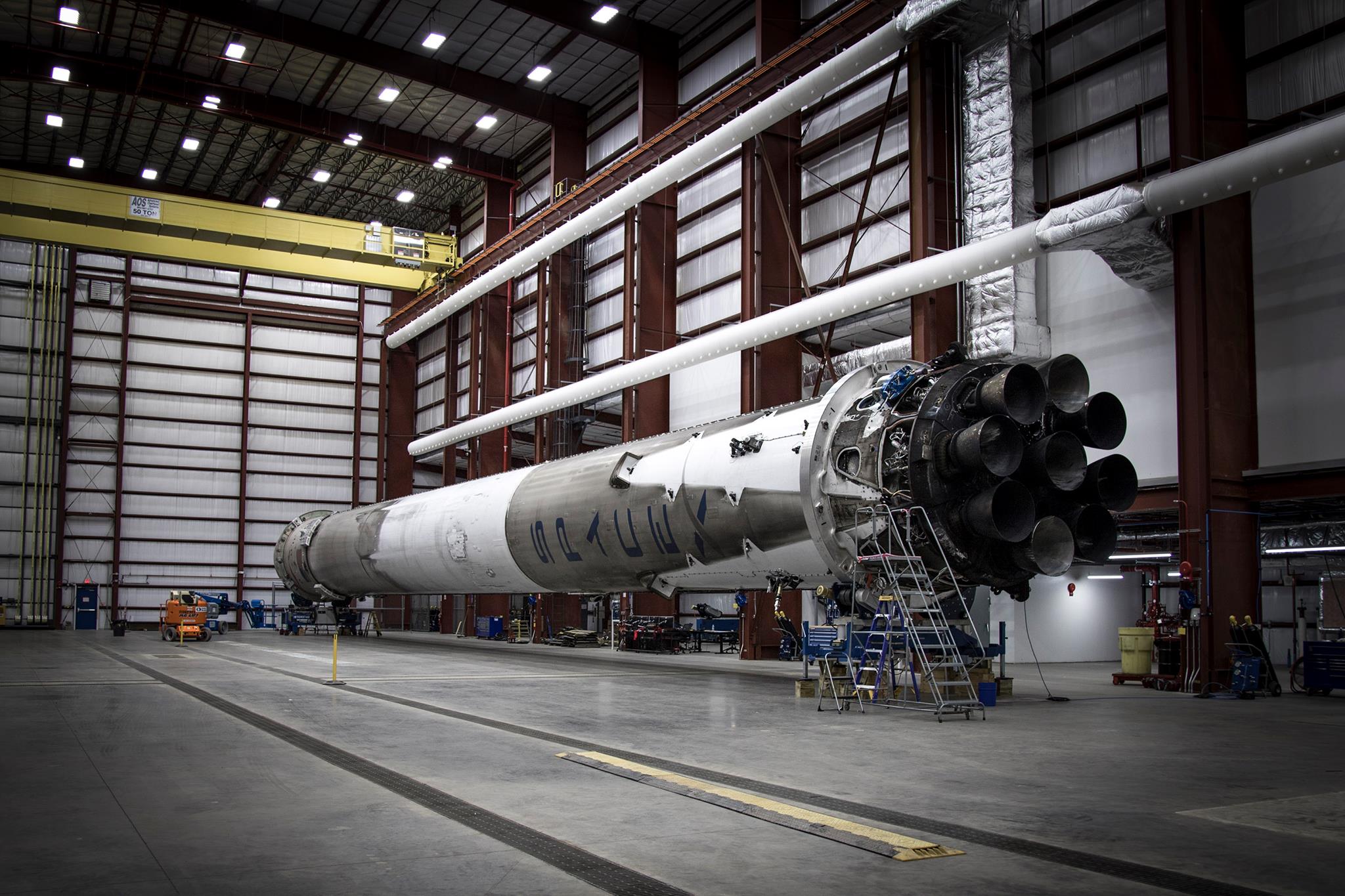
In the hangar, we see that technological hatches were removed from the stage to inspect the engines and communications in the tail compartment. The line of dividing tanks with a smoked bottom tank is striking, then the structure is almost white, and then soot again from above. It just on the bottom of the oxidizer tank was frost. Most likely, it was also sootted with soot, but it subsequently melted and the soot of the glass down or frost simply fell off.
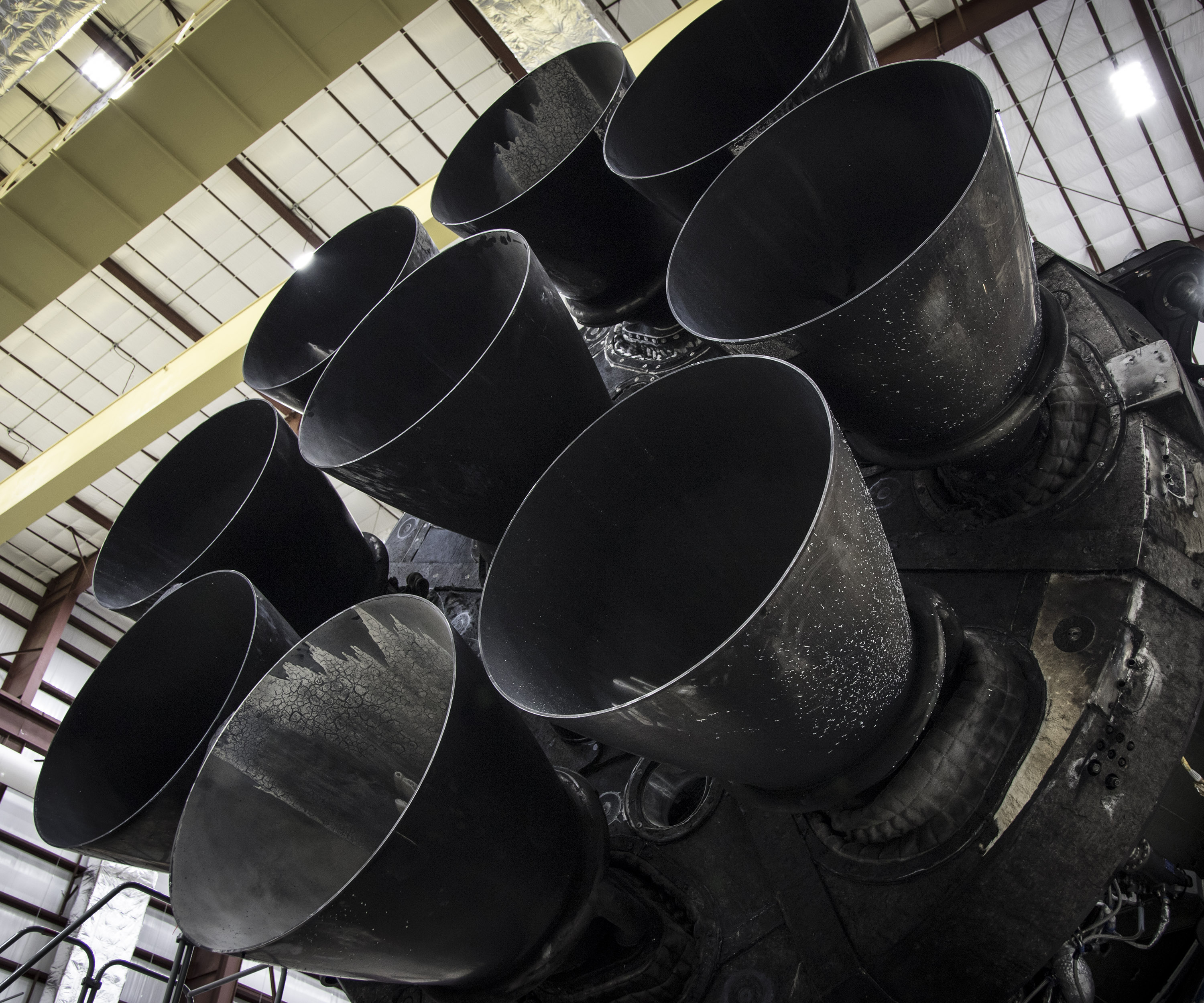
It can be seen that the soot on the engine has settled tight enough and it will be quite difficult to wash it off. In principle, engine specialists currently cannot give a meaningful answer about soot. When conducting multiple tests on one engine, it is often not cleaned of soot. But when it is delivered to the rocket and for visual inspection, everything is cleaned to a shine without fail. In the end, let's see what will do with soot on SpaceX engines. The bottom screen panels are removable in principle and can be cleaned autonomously. It is not clear how SpaceX will clean the tail section; engines may need to be removed. At the same time, it is required to take seriously enough the issues of cleaning the end surface of the tail compartment. In flight, the engine flame emits energy very well and the degree of blackness of the surface can be crucial for not burnout the structure. If you look at the tail compartments of the Soyuz launch vehicle blocks, you can see shiny surfaces from the end and even from the side. These are polished sheets of titanium at the end of the central unit and chrome steel sheets in other places. Sheets are installed on an asbestos substrate.

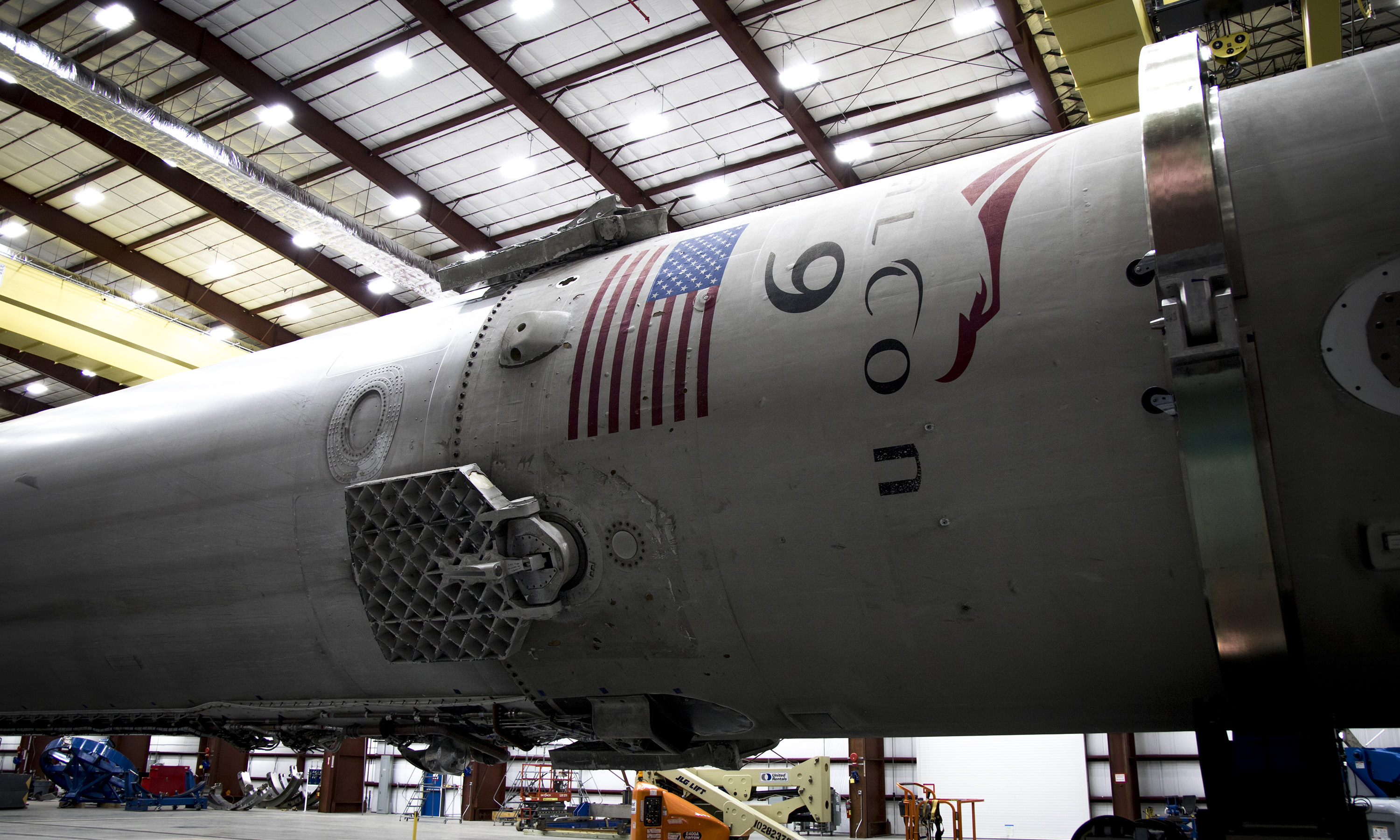
Next, we see the state of the cylindrical surface of the first stage. It can be seen that the step coating is seriously affected by the effects of temperature, and maybe soot. When heated, the enamel used on the Falcon-9 began to move away from the base, partly flew off and went into bubbles. By the way, the coverage here acts as an indicator. It can be seen that there was a slight heating, which did not lead to a change in the color of enamel on metal structures. But the state on the composite interstage adapter is striking. In principle, it is mainly on it that the enamel began to recede. This is due to the fact that the thermal conductivity of the composite is worse than that of metals, which in turn leads to overheating of the enamel. This enamel must be restored. Minor repairs as well as complete repainting are possible. People with the most acute vision may or may not see a change in the color of enamel in a brownish tint on the interstage adapter, which may additionally indicate an overheating of the enamel. The problem of enamel recovery can be solved in a radical way - just do not paint the step, which was successfully used on the Proton launch vehicle. True, coatings are needed that will reliably protect the structure from corrosion and erosion for a long time in constant operation.
As a result, SpaceX came close to answering the question - what problems await us when reusing rocket blocks of the first stages of rockets. At first glance, the reusable step is suitable. The problem with soot will be solved either by constructive and technological measures to simplify cleaning, or by radically replacing kerosene with methane. Next, the question of the suitability of engines for multiple flights should be answered. According to experience, the selected engine design allows for a long service life of the structure without a drop in reliability. According to Elon Mask, they have already worked out the engine for four times the resource for ten times the use. Theoretically, this is enough. Again, soot in the engine can occur as a serious problem. But since SpaceX tested the engine for more than 40 flight cycles, they probably know that it’s not a problem, or they are hiding something. True, the tests often differ from the actual flight and can get out problems in the engines during real flights. The resource for the design of the stage is rather trivially provided by constructive solutions, and most likely SpaceX specialists know these solutions and will probably or will already apply them in the reusable version. Reusability of units and devices is provided by methods of their automatic diagnostics and replacement in case of failure. So we will wait for the fire tests and further landings. The resource for the design of the stage is rather trivially provided by constructive solutions, and most likely SpaceX specialists know these solutions and will probably or will already apply them in the reusable version. Reusability of units and devices is provided by methods of their automatic diagnostics and replacement in case of failure. So we will wait for the fire tests and further landings. The resource for the design of the stage is rather trivially provided by constructive solutions, and most likely SpaceX specialists know these solutions and will probably or will already apply them in the reusable version. Reusability of units and devices is provided by methods of their automatic diagnostics and replacement in case of failure. So we will wait for the fire tests and further landings.
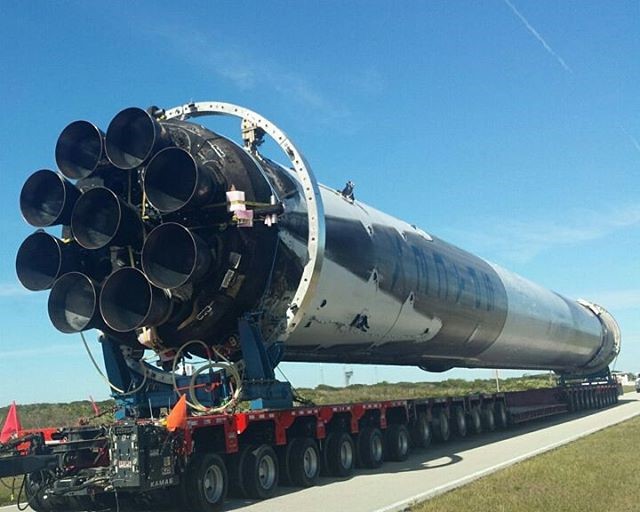
Before I could finish the review, a new photograph of the Falcon-9 reusable stage appeared. According to available information, the step was photographed during transportation to the SLC-40 launch pad for burning, which will take place on January 14. It can be seen that SpaceX did not begin to clean the soot from the stage. There is an opinion that in this way SpaceX show that this is exactly the landed stage without replacing the elements. This is a fairly logical explanation. But if you look closely, you can see that the step was washed a little and the soot shines in the sun. It is also likely that they tried to clean the engines. It can be seen that one of the engines inside is slightly whiter than the rest. This can serve as evidence that they wanted to clean it of soot, maybe for testing. As a result, it’s not clear why the step in soot - specifically, we decided to save, no need to clean in principle, or tried and failed. Everyone thinks they will choose the most suitable version for themselves. And we are waiting for the test stage at the stand, where I think there will be a new amount of information for thought.
In conclusion, it should be noted that, without having our own experience and our returning first stage or its analogue, we can only observe how the situation with the reusability of SpaceX and Blue Origin in photographs and videos is.
Pavel Pushkin .
Cosmocourse page in Vkontakte .
